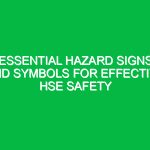Introduction
Understanding hazard symbols meaning is crucial for anyone involved in health, safety, and environmental (HSE) practices. These symbols serve as essential visual cues that convey important information about potential hazards associated with chemicals, materials, and various workplace environments. Given the myriad of substances and processes that surround us, recognizing these symbols can significantly enhance safety measures and reduce the risk of accidents. This article aims to provide a comprehensive exploration of hazard symbols, their meanings, and their relevance within the HSE context. By delving into the intricacies of these symbols, we can equip ourselves with the knowledge to foster a safer workplace.
The Importance of Hazard Symbols
At its core, the meaning of hazard symbols lies in their ability to communicate risks quickly and effectively. For instance, a simple label can indicate that a substance is flammable, corrosive, or toxic. These visual representations are not just arbitrary marks; they are grounded in international standards and regulations designed to protect individuals and the environment.
Effective communication of hazards can prevent accidents and injuries. In many cases, the presence of hazard symbols has been linked to a decrease in workplace incidents. For example, a construction site that clearly displays hazard signage can help workers identify dangerous areas, leading to improved safety protocols and practices. This proactive approach is an integral part of HSE management systems.
Types of Hazard Symbols
When we look at hazard symbols, we can categorize them into several key types, each conveying specific risks. Understanding these categories is essential for anyone working in or around hazardous materials.
1. Chemical Hazard Symbols
Chemical hazard symbols are perhaps the most recognized type. These symbols are standardized under the Globally Harmonized System of Classification and Labelling of Chemicals (GHS). The GHS provides a framework for classifying chemicals based on their hazards, and it includes a series of pictograms that represent different types of risks.
- Flame: Indicates flammable gases, liquids, and solids.
- Skull and Crossbones: Represents acute toxicity.
- Corrosion: Signifies a corrosive substance that can destroy living tissue or materials.
- Exclamation Mark: A general symbol for hazards that cause less severe health effects or damage to the ozone layer.
- Health Hazard: Indicates a potential health risk that could cause serious health effects.
Understanding these symbols is vital for anyone handling chemicals in a laboratory, industrial setting, or even at home. For instance, a lab technician must be aware of the implications of a “corrosion” symbol on a bottle of acid to ensure proper handling and safety measures.
2. Physical Hazard Symbols
Physical hazards encompass risks that can cause physical harm. These symbols often denote dangers associated with machinery, electrical equipment, and other physical factors.
- Exploding Bomb: Signifies explosives or self-reactive substances.
- Radiation: Indicates the presence of radioactive materials.
- Electrical Hazard: Warns of electric shock risks.
For example, a factory worker who encounters an “exploding bomb” symbol must take immediate precautions, such as wearing protective gear or adhering to specific operational protocols to mitigate risks.
3. Environmental Hazard Symbols
Environmental hazard symbols focus on risks that can affect the environment. These symbols highlight substances that may pose threats to ecosystems or wildlife.
- Dead Fish: Indicates substances that are harmful to aquatic life.
- Tree with a Slash: Signifies environmental hazards that can damage flora and fauna.
Awareness of these symbols is crucial for industries that interact with natural resources. For instance, a chemical plant must ensure that its waste disposal practices do not lead to environmental contamination, as indicated by the presence of these hazard symbols.
Real-Life Applications and Case Studies
To illustrate the importance of understanding hazard symbols, consider the following hypothetical scenario:
A construction site manager, Sarah, is responsible for overseeing a project that involves the use of various chemicals, including solvents and adhesives. As part of her safety training, she familiarizes herself with the chemical hazard symbols present on the materials used. During a routine inspection, she notices that a container of adhesive is marked with the “exclamation mark” symbol. Recognizing the potential for skin irritation, she ensures that all workers wear gloves and protective gear while handling the material. This proactive measure prevents an incident that could have resulted in injuries and lost time for the project.
Another real-life example involves a chemical manufacturing plant that underwent an audit by health and safety regulators. The audit revealed that several chemicals were improperly labeled, leading to confusion among employees about their handling. Upon rectifying these issues and implementing a comprehensive training program focused on hazard symbols, the plant reported a significant decrease in workplace injuries and incidents. This case underscores the crucial role that hazard symbols play in fostering a culture of safety.
Regulations and Standards
The significance of hazard symbols is further emphasized by various regulations and standards governing their use. Compliance with these regulations is not only a legal requirement but also a fundamental aspect of a robust HSE framework.
Globally Harmonized System (GHS)
The GHS provides a standardized approach to hazard classification and communication. This system ensures that chemical manufacturers and importers label their products with the appropriate hazard symbols, thereby enhancing safety across borders. The GHS has been adopted by many countries, including member states of the European Union and the United States, making it an essential standard for international trade.
Occupational Safety and Health Administration (OSHA)
In the United States, OSHA regulations mandate that employers provide a safe workplace, which includes proper labeling of hazardous materials. Employers must ensure that hazard symbols are clearly displayed and understood by all employees. Failure to comply with OSHA regulations can result in fines and increased liability in the event of an accident.
Environmental Protection Agency (EPA)
The EPA also plays a role in regulating hazardous substances, particularly those that may harm the environment. Understanding hazard symbols related to environmental risks is crucial for industries that handle chemicals, as compliance with EPA regulations is necessary to protect ecosystems and public health.
Best Practices for Understanding Hazard Symbols
To effectively navigate the world of hazard symbols, consider the following best practices:
- Training: Provide regular training sessions for employees to familiarize them with hazard symbols and their meanings. This should include hands-on demonstrations and real-world scenarios.
- Clear Labeling: Ensure that all hazardous materials are clearly labeled with the appropriate symbols. Labels should be easily visible and legible.
- Regular Audits: Conduct regular safety audits to assess compliance with hazard symbol regulations. Address any discrepancies promptly.
- Engagement: Foster an open dialogue about safety within the workplace. Encourage employees to voice concerns or seek clarification about hazard symbols.
Implementing these best practices can create a culture of safety and awareness, minimizing the risks associated with hazardous materials.
Conclusion
In summary, understanding hazard symbols meaning is vital for promoting health, safety, and environmental sustainability in the workplace. These symbols serve as important indicators of risk, enabling individuals to make informed decisions when handling hazardous materials. Through proper training, clear labeling, and adherence to regulations, we can unlock the full potential of hazard symbols to create safer environments.
As we continue to navigate a world filled with various hazards, let us remain vigilant and proactive in our approach to safety. By prioritizing education and awareness, we can ensure that we are well-equipped to identify and respond to potential risks, safeguarding not only our health but also the well-being of those around us. Remember, safety is a shared responsibility, and understanding hazard symbols is a crucial step in the right direction.


